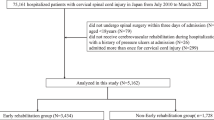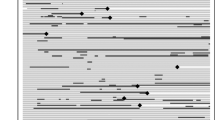Abstract
Study design:
Secondary analysis of data from a prospective cohort study.
Objectives:
The objective of this study was to identify the medical and demographic factors associated with the development of pressure ulcers during acute-care hospitalization and inpatient rehabilitation following acute spinal cord injury.
Setting:
The study was carried out at acute hospitalization, inpatient rehabilitation and outpatient rehabilitation sites at a university medical center in the United States.
Methods:
Adults with acute traumatic spinal cord injury (n=104) were recruited within 24–72 h of admission to the hospital. Pressure ulcer incidence was recorded.
Results:
Thirty-nine participants out of 104 (37.5%) developed at least one pressure ulcer during acute-care hospitalization and inpatient rehabilitation. Univariate logistic regression analyses revealed significant association of pressure ulcer incidence for those with pneumonia and mechanical ventilation (P=0.01) and higher injury severity (ASIA A) (P=0.01). Multiple logistic regression showed that the odds of formation of a first pressure ulcer in participants with ASIA A was 4.5 times greater than that for participants with ASIA B, CI (1–20.65), P=0.05, and 4.6 times greater than that for participants with ASIA C, CI (1.3–16.63), P=0.01.
Conclusion:
Among individuals with acute traumatic SCI, those with high-injury severity were at an increased risk to develop pressure ulcers. Pneumonia was noted to be associated with the formation of pressure ulcers.
Similar content being viewed by others
Log in or create a free account to read this content
Gain free access to this article, as well as selected content from this journal and more on nature.com
or
References
Dumont RJ, Okonkwo DO, Verma S, Hurlbert RJ, Boulos PT, Ellegala DB et al. Acute spinal cord injury, part I: pathophysiologic mechanisms. Clin Neuropharmacol 2001; 24: 254–264.
Hitzig SL, Tonack M, Campbell KA, McGillivray CF, Boschen KA, Richards K et al. Secondary health complications in an aging Canadian spinal cord injury sample. Am J Phys Med Rehabil 2008; 87: 545–555.
NSCISCAnnual report for the model spinal cord injury care systems. N.S.C.I.S. Center: Birmingham, AL, 2011.
National Spinal Cord Injury Statistical CenterAnnual report for the model spinal cord injury care systems. N.S.C.I.S. Center: Birmingham, AL, 2006.
Garber SL, Rintala DH, Hart KA, Fuhrer MJ . Pressure ulcer risk in spinal cord injury: predictors of ulcer status over 3 years. Arch Phys Med Rehabil 2000; 81: 465–471.
Cardenas DD, Hoffman JM, Kirshblum S, McKinley W . Etiology and incidence of rehospitalization after traumatic spinal cord injury: a multicenter analysis. Arch Phys Med Rehab 2004; 85: 1757.
Krause JS, Saunders LL . Health, secondary conditions, and life expectancy after spinal cord injury. Arch Phys Med Rehabil 2011; 92: 1770–1775.
Savic G, Short D, Weitzenkamp D, Charlifue S, Gardner B . Hospital readmissions in people with chronic spinal cord injury. Spinal Cord 2000; 38: 371.
Salzberg C, Byrne DW, Cayten GC, Kabir R, van Niewerburgh P, Viehbeck M et al. Predicting and preventing pressure ulcers in adults with paralysis. Adv Skin Wound Care 1998; 11: 237–246.
McKinley W, Tewksbury M, Godbout C . Comparison of medical complications following nontraumatic and traumatic spinal cord injury. J Spinal Cord Med 2002; 25: 88–93.
Chen D, Apple DF Jr, Hudson LM, Bode R . Medical complications during acute rehabilitation following spinal cord injury—current experience of the Model Systems. Arch Phys Med Rehabil 1999; 80: 1397.
Krause JS, Vines CL, Farley TL, Sniezek J, Coker J . An exploratory study of pressure ulcers after spinal cord injury: Relationship to protective behaviors and risk factors. Arch Phys Med Rehabil 2001; 82: 107–113.
Salzberg CA, Byrne DW, Cayten CG, van Niewerburgh P, Murphy JG, Viehbeck M . A new pressure ulcer risk assessment scale for individuals with spinal cord injury1. Am J Phys Med Rehab 1996; 75: 96–104.
Çakmak SK, Gül Ü, Özer S, Yigit Z, Gönü M . Risk factors for pressure ulcers. Adv Skin Wound Care 2009; 22: 412–415.
Wilczweski P, Grimm D, Gianakis A, Gill B, Sarver W, McNett M . Risk factors associated with pressure ulcer development in critically ill traumatic spinal cord injury patients. J Trauma Nurs 2012; 19: 5–10.
Fogerty MD, Abumrad NN, Nanney L, Arbogast PG, Poulose B, Barbul A . Risk factors for pressure ulcers in acute care hospitals. Wound Repair Regen 2008; 16: 11–18.
Manzano F, Navarro MJ, Roldán D, Moral MA, Leyva I, Guerrero C et al. Pressure ulcer incidence and risk factors in ventilated intensive care patients. J Crit Care 2010; 25: 469–476.
Banks M, Graves N, Bauer J, Ash S . Cost effectiveness of nutrition support in the prevention of pressure ulcer in hospitals. Eur J Clin Nutr 2012; 67: 42–46.
Watts D, Abrahams E, MacMillan C, Sanat J, Silver R, Van Gorder S et al. Insult after injury: pressure ulcers in trauma patients. Orthop Nurs 1998; 17: 84–91.
Reddy M, Gill SS, Rochon PA . Preventing pressure ulcers: a systematic review. JAMA 2006; 296: 974–984.
Peerless JR, Davies A, Klein D, Yu D . Skin complications in the intensive care unit. Clin Chest Med 1999; 20: 453–467.
Stover SL, DeLisa JA, Whiteneck GG Spinal Cord Injury: Clinical Outcomes From The Model Systems. Aspen Publishers, New York, NY, USA, 1995.
Rodriguez G, Garber S . Prospective study of pressure ulcer risk in spinal cord injury patients. Spinal Cord 1994; 32: 150–158.
Gelis A, Dupeyron A, Legros P, Benaim C, Pelissier J, Fattal C . Pressure ulcer risk factors in persons with spinal cord injury part 2: the chronic stage. Spinal Cord 2009; 47: 651–661.
Garber SL, Rintala DH . Pressure ulcers in veterans with spinal cord injury: a retrospective study. J Rehabil Res Dev 2003; 40: 433–442.
Correa G, Fuentes M, Gonzalez X, Cumsille F, Pineros J, Finkelstein J . Predictive factors for pressure ulcers in the ambulatory stage of spinal cord injury patients. Spinal Cord 2006; 44: 734–739.
Chen Y, DeVivo MJ, Jackson AB . Pressure ulcer prevalence in people with spinal cord injury: age-period-duration effects. Arch Phys Med Rehabil 2005; 86: 1208–1213.
Ziraldo C, Solovyev A, Allegretti A, Krishnan S, Henzel MK, Sowa GA et al. A computational, tissue-realistic model of pressure ulcer formation in individuals with spinal cord injury. PLoS Comput Biol 2015; 11: e1004309.
Byrne D, Salzberg C . Major risk factors for pressure ulcers in the spinal cord disabled: a literature review. Spinal Cord 1996; 34: 255–263.
Marino RJ, Barros T, Biering-Sorensen F, Burns SP, Donovan WH, Graves DE et al. International standards for neurological classification of spinal cord injury. J Spinal Cord Med 2003; 26: S50.
Baker SP, o'Neill B, Haddon W Jr, Long WB . The injury severity score: a method for describing patients with multiple injuries and evaluating emergency care. J Trauma 1974; 14: 187–196.
NPUAP/EPUAP/PPPIA. National Pressure U lcer Advisory Panel/European Pressure Ulcer Advisory Panel/Pan Pacific Pressure Injury Alliance: Prevention and Treatment of Pressure Ulcers: Clinical Practice Guideline. Haesler E (ed.). NPUAP/EPUAP/PPPIA: Perth, Australia, 1–308, 2014. Available at http://internationalguideline.com.
Peduzzi P, Concato J, Kemper E, Holford TR, Feinstein AR . A simulation study of the number of events per variable in logistic regression analysis. J Clin Epidemiol 1996; 49: 1373–1379.
Zweig MH, Campbell G . Receiver-operating characteristic (ROC) plots: a fundamental evaluation tool in clinical medicine. Clin Chem 1993; 39: 561–577.
DeVivo MJ . Epidemiology of traumatic spinal cord injury: trends and future implications. Spinal Cord 2012; 50: 365–372.
New PW, Rawicki HB, Bailey MJ . Nontraumatic spinal cord injury rehabilitation: pressure ulcer patterns, prediction, and impact. Arch Phys Med Rehabil 2004; 85: 87–93.
Hammond M, Bozzacco V, Stiens S, Buhrer R, Lyman P . Pressure ulcer incidence on a spinal cord injury unit. Adv Wound Care 1994; 7: 57.
Taghipoor KD, Arejan RH, Rasouli MR, Saadat S, Moghadam M, Vaccaro AR et al. Factors associated with pressure ulcers in patients with complete or sensory-only preserved spinal cord injury: is there any difference between traumatic and nontraumatic causes? Clinical article. J Neurosurg 2009; 11: 438–444.
Scheel-Sailer A, Wyss A, Boldt C, Post M, Lay V . Prevalence, location, grade of pressure ulcers and association with specific patient characteristics in adult spinal cord injury patients during the hospital stay: a prospective cohort study. Spinal Cord 2013; 51: 828–833.
Fuhrer MJ, Garber SL, Rintala DH, Clearman R, Hart KA . Pressure ulcers in community-resident persons with spinal cord injury: prevalence and risk factors. Arch Phys Med Rehabil 1993; 74: 1172–1177.
Celani MG, Spizzichino L, Ricci S, Zampolini M, Franceschini M . Spinal cord injury in Italy: a multicenter retrospective study. Arch Phys Med Rehabil 2001; 82: 589–596.
Idowu O, Yinusa W, Gbadegesin S, Adebule G . Risk factors for pressure ulceration in a resource constrained spinal injury service. Spinal Cord 2011; 49: 643–647.
McKinley WO, Jackson AB, Cardenas DD, De Vivo MJ . Long-term medical complications after traumatic spinal cord injury: a regional model systems analysis. Arch Phys Med Rehabil 1999; 80: 1402–1410.
Krishnan S, Karg PE, Boninger ML, Brienza DM . Association between presence of pneumonia and pressure ulcer formation following traumatic spinal cord injury. J Spinal Cord Med 2016; 40: 415–422.
Krishnan S, Vodovotz Y, Karg PE, Constantine G, Sowa GA, Constantine FJ et al. Inflammatory mediators associated with pressure ulcer development in individuals with pneumonia after traumatic spinal cord injury: a pilot study. Arch Phys Med Rehabil, (e-pub ahead of print 25 January 2017; doi: 10.1016/j.apmr.2016.12.018).
Esposito S, Noviello S, Leone S . Catheter-associated urinary tract infections: epidemiology and prevention]. Infez Med 2008; 16: 130.
Gould CV, Umscheid CA, Agarwal RK, Kuntz G, Pegues DA . Guideline for prevention of catheter‐associated urinary tract infections 2009. Infect Control Hosp Epidemiol 2010; 31: 319–326.
Grey JE, Harding KG, Enoch S . Pressure ulcers. Br Med J 2006; 7539: 472.
Brandeis GH, Ooi WL, Hossain M, Morris JN, Lipsitz LA . A longitudinal study of risk factors associated with the formation of pressure ulcers in nursing homes. J Am Geriatr Soc 1994; 42: 388.
Acknowledgements
This work was funded by the National Institute on Disability and Rehabilitation Research (NIDRR), Rehabilitation Engineering Research Center (RERC) on Spinal Cord Injury, Grant #H133E070024. Additional support was received from the NIDILRR Interdisciplinary Rehabilitation Research Training Program (Postdoctoral) Grant #90AR5009.
Author information
Authors and Affiliations
Corresponding author
Ethics declarations
Competing interests
The authors declare no conflict of interest.
Rights and permissions
About this article
Cite this article
Brienza, D., Krishnan, S., Karg, P. et al. Predictors of pressure ulcer incidence following traumatic spinal cord injury: a secondary analysis of a prospective longitudinal study. Spinal Cord 56, 28–34 (2018). https://doi.org/10.1038/sc.2017.96
Received:
Revised:
Accepted:
Published:
Issue date:
DOI: https://doi.org/10.1038/sc.2017.96
This article is cited by
-
Application of novel strategies in chronic wound management with focusing on pressure ulcers: new perspective
Archives of Dermatological Research (2025)
-
Predictors of hospital-acquired pressure injuries in patients with complete spinal cord injury: a retrospective case–control study
BMC Musculoskeletal Disorders (2023)
-
Continuous pressure monitoring of inpatient spinal cord injured patients: implications for pressure ulcer development
Spinal Cord (2023)
-
Risk factors for hospital acquired pressure injury in patients with spinal cord injury during first rehabilitation: prospective cohort study
Spinal Cord (2022)
-
Healthcare-associated infection after spinal cord injury in a tertiary rehabilitation center in South Korea: a retrospective chart audit
Spinal Cord (2021)



